Fun Facts About Amazing Atlantic Salmon
An endangered species, Atlantic salmon are now being raised in hatcheries and outfitted with satellite tags to keep track of their migration patterns.
- What’s the difference between Atlantic and Pacific Salmon?
- Where do Atlantic salmon live?
- Why do salmon go to sea?
- When do Atlantic salmon migrate to the ocean?
- How old are Atlantic salmon when they migrate from freshwater to the ocean?
- Where do Atlantic salmon go in the ocean?
- What is a landlocked salmon?
- What do Atlantic salmon eat?
- What eats Atlantic salmon?
- How large do salmon get?
- What is the oldest known age of Atlantic salmon?
- Do salmon return to spawn in freshwater areas where they were born?
- How many eggs do Atlantic salmon have?
- What is the ESA and how does it relate to salmon?
- Why are there so few Atlantic salmon left in New England rivers?
- Why are hatcheries raising salmon?
- How many of the young salmon released from hatcheries come back as adults?
- Why are fish ladders constructed?
- What Was the Presidential Salmon?
- Other Fun Facts Pages
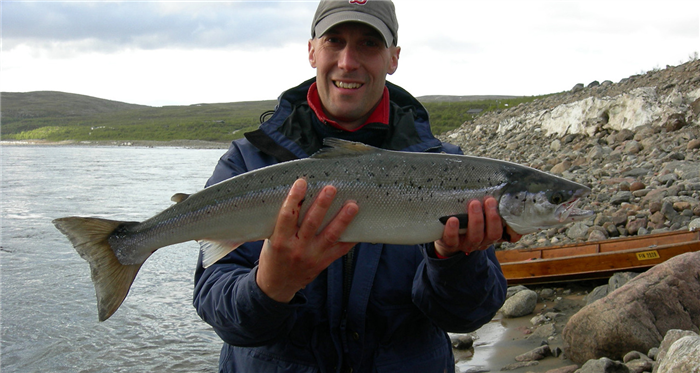
What’s the difference between Atlantic and Pacific Salmon?
The Atlantic salmon is actually one species within the genus Salmo. There are seven different species of Pacific salmon, which belong to the genus Oncorhynchus.
Atlantic salmon generally don’t live long after spawning but are capable of surviving and spawning again. Most Pacific salmon die shortly after spawning, with the exception of steelhead.
Where do Atlantic salmon live?
Atlantic salmon used to be found from Long Island Sound to New England, but those populations no longer exist in these rivers. Currently U.S. Atlantic salmon are only found in a handful of rivers in Maine.
Atlantic salmon go to sea to grow. The energy content and abundance of food in the ocean is much higher than in freshwater, so fish are able to grow very big, very quickly. This is important because larger fish are less likely to be eaten and the females have more eggs. A lot of eggs are needed to produce enough juveniles that will grow to maturity and return to spawn and sustain the population.
When do Atlantic salmon migrate to the ocean?
Young Atlantic salmon (called “smolts”) migrate to sea every year in the spring. The “smolt run” in the Gulf of Maine begins in the middle of April and is over by the beginning of June. Due to regional climate impacts, the smolt run is starting earlier than in the past. The run begins later at northern latitudes.
Atlantic salmon smolt are usually 2-3 years old when they begin their migration in U.S. waters, but migrating smolt are often older at higher latitudes.
Where do Atlantic salmon go in the ocean?
North American Atlantic salmon migrate in the spring from the rivers where they were born. They move into the Labrador Sea for their first summer, autumn, and winter. The following spring they move to the coastal waters of Labrador and the Canadian Arctic, West Greenland, and sometimes to the waters of East Greenland. After a second winter at sea, adults from many populations are large and mature enough to spawn, and they migrate back to freshwater areas to reproduce.
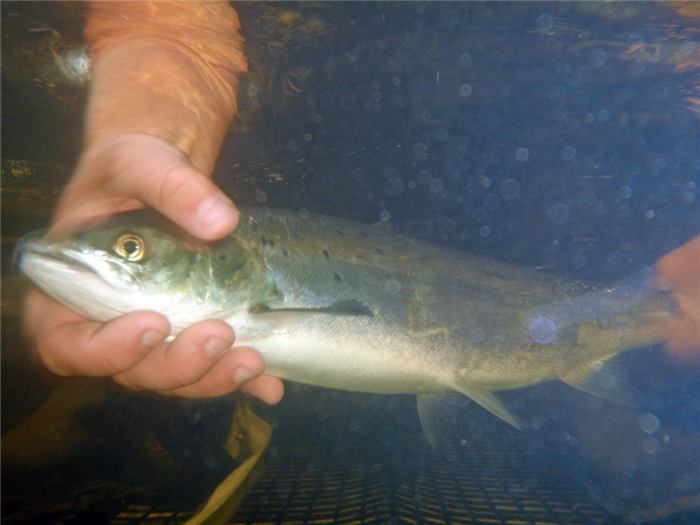
Atlantic salmon grilse.
A landlocked Atlantic salmon is a freshwater form of the sea-run Atlantic salmon. They are genetically considered a subspecies of the sea-run Atlantic salmon. They reside in lakes, never making the marine migration. They generally do not grow as large as sea-run fish, averaging between 12 and 20 inches long.
What do Atlantic salmon eat?
In fresh water, young salmon mostly eat small insects such as mayflies, stoneflies, caddisflies, blackflies, and riffle beetles. Sometimes they eat small amphibians and fish.
When they’re in the ocean, young and adult salmon eat a wide variety of prey, including:
- Fish such as capelin, Atlantic herring, sand lance, barracudina and lanternfish.
- Crustaceans such as amphipods and euphausiids or “krill.”
- Cephalopods like squid and octopus.
- Polychaete worms.
Just before adults migrate to estuaries to begin the spawning migration, they stop eating altogether.
What eats Atlantic salmon?
In freshwater, juveniles are eaten by a variety of fish (smallmouth bass, striped bass, Northern pike, slimy sculpin, etc.), birds (kingfisher, double-crested cormorant, mergansers, osprey, blue heron, snowy egret, etc.), and mammals (otter, mink, etc.).
In the ocean, Atlantic salmon are eaten by:
- Large predatory fish like Atlantic halibut, Atlantic bluefin tuna, swordfish, and striped bass.
- Greenland shark, mako sharks, porbeagle sharks, and other sharks.
- Seabirds such as the Northern gannet.
- Various seals (harp, grey, harbor, etc.).
- Toothed whales like killer whales, dolphins, and porpoises.
Atlantic salmon are also caught for consumption by humans in targeted aboriginal or traditional First Nations fisheries.
How large do salmon get?
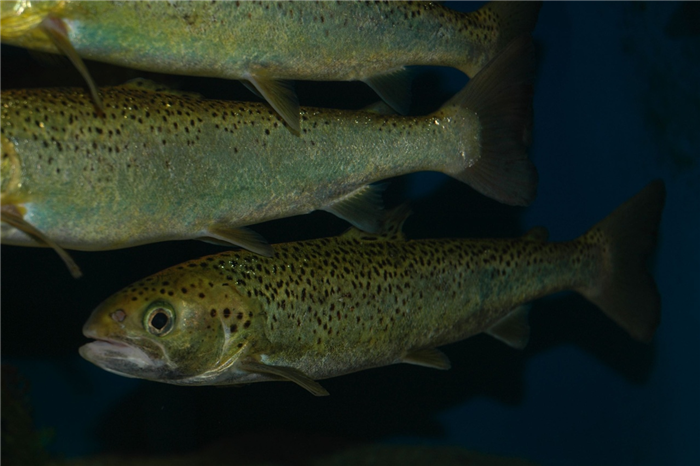
The largest Atlantic salmon was 105 pounds and 60 inches. However, depending on how long they are at sea, adults returning to the Gulf of Maine rivers typically weigh approximately 7-12 lbs and are 28-32 inches long after 2 years at sea.
What is the oldest known age of Atlantic salmon?
The maximum recorded age was 13 years old, but most Atlantic salmon that survive to reproduce live 5 to 8 years (1-7 years in fresh water, 1-6 years in the marine environment).
Almost always. While some straying has been documented, most spawning salmon return to the river in which they were born and sometimes they even home to the very stream of their birth.
How many eggs do Atlantic salmon have?
Generally from 2,500 to 7,000 depending on the size of the female (larger females have more eggs), or about 600-800 eggs per pound of body weight.
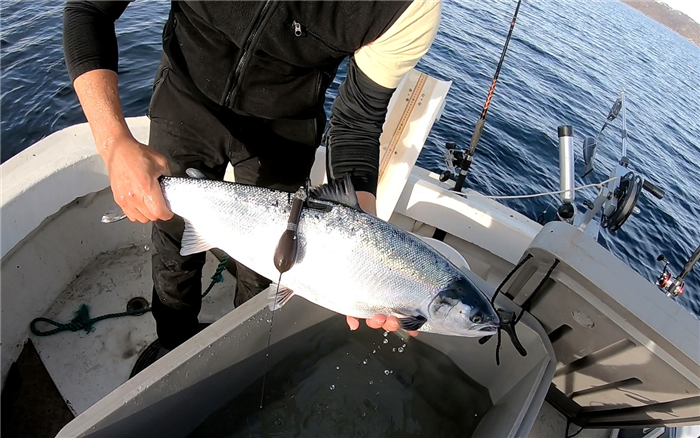
Salmon tagged and ready for release.
What is the ESA and how does it relate to salmon?
The Endangered Species Act (ESA) is a law passed in 1973 that provides for the protection and conservation of species that are at very high risk of going extinct. Atlantic salmon populations in the Gulf of Maine are listed as endangered under the ESA. This means that they are in danger of extinction throughout all or part of their range. Before construction of dams in the early 1830s, more than 100,000 Atlantic salmon returned to U.S. rivers each year; now adult returns are usually less than 1,000.
There are many reasons why U.S. Atlantic salmon population abundances are so low. There are three primary causes:
- Habitat degradation: Centuries of industrialization on New England rivers (e.g., paper and textile mills, deforestation of riparian areas and log drives) has resulted in the degradation of a lot of the fishes’ spawning and rearing habitat, effectively reducing the productive capacity of our rivers.
- Barriers to migration: Barriers, such as dams and hydroelectric power plants, and poorly designed culverts at road crossings can delay or prevent juvenile salmon swimming downstream and adults swimming upstream. This can make it difficult or impossible for them to reach the habitats they need to survive.
- Marine survival: Recently, fewer Atlantic salmon have survived their journey to the Northwest Atlantic. Potential drivers include harvest, starvation (via thermal habitat and food food-web changes), predation, and disease.
Why are hatcheries raising salmon?
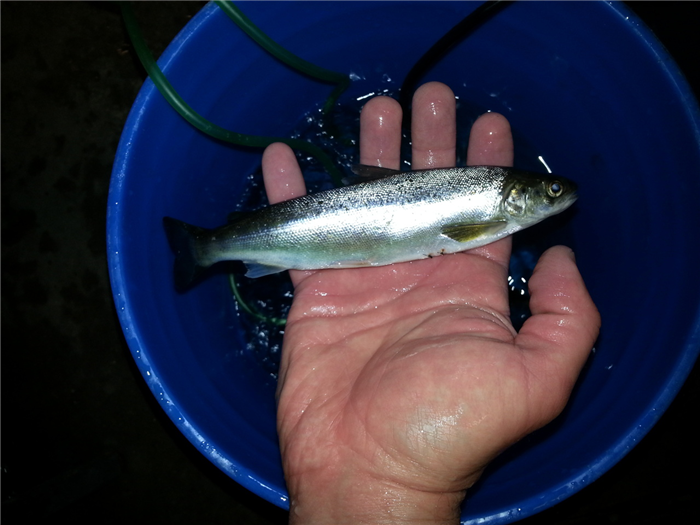
Hatchery salmon smolt. Credit: NOAA Fisheries
Salmon are raised in hatcheries to supplement natural production in rivers. U.S. Atlantic salmon are endangered and are currently unable to produce enough juveniles under natural conditions in the rivers to support their populations. Therefore, juveniles are raised in hatcheries to various stages (i.e., fry, fingerling, parr, and smolt) to enhance survival at early life stages. Then they are stocked in the rivers so that they can migrate to sea then return to spawn after a few years. Stocking helps maintain endangered populations so they don’t go extinct. This gives scientists and managers more time to figure out how to restore thriving populations to Gulf of Maine rivers again.
How many of the young salmon released from hatcheries come back as adults?
From 2010-2015, releases of hatchery-raised Atlantic salmon smolt to supplement natural production in the streams of the Gulf of Maine resulted in adult spawning returns of approximately 0.08-0.71%. This low return rate is the result of numerous factors including high mortality in the river from downstream passage barriers and low marine survival.
Fish passage is essential for adult salmon to be able to travel upriver to spawn and for salmon smolts to be able to travel down river to reach the sea. A fish ladder, or fishway, is often constructed to help salmon swim upstream around a dam or a natural barrier that might prevent or impede progress to spawning grounds. Downstream passage of migrating smolts and some post-spawned adults past barriers is sometimes provided by constructing a bypass structure or by allowing sufficient amounts of water to spill over a dam.
What Was the Presidential Salmon?
Before the decline of Atlantic salmon, anglers competed annually to land the largest spring salmon. The Presidential Salmon Tradition was born out of a Penobscot River competition when, in 1912, Karl Anderson sent his winning 22-pound salmon to President Taft. The tradition was suspended due to low salmon abundance in 1992. President George H. W. Bush was the last President to receive a Presidential salmon.
Thanks to Ruth Haas-Castro of the Atlantic Salmon Ecosystems Research Team for her input on this page.
What Do Salmon Eat? 12 Foods in Their Diet
Salmon are famous for their returning to their home streams to spawn, leaping out of the water along the way. Although they may seem like the least-interesting fish, salmon are actually unique because many species spend part of their lives in freshwater and another portion in the salty waters of the open ocean. They have to feed in each situation, so what do salmon eat?
Take a journey into the life of a very common, unassuming fish and learn how salmon survive in difficult circumstances along with the role that humans play in their lives.
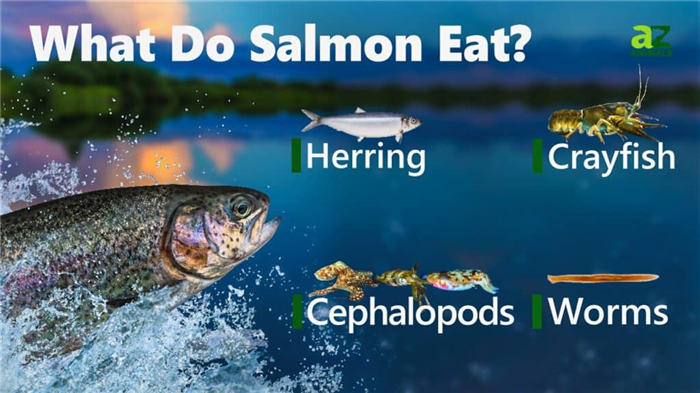
Salmon eat herring, crayfish, worms, cephalopods, and more.
What Foods Do Salmon Eat?
Salmon eat insects, amphibians, and fish. They are strictly carnivorous creatures that feed on others no matter if they are living in freshwater or saltwater. However, the salmon’s diet varies significantly depending on where it’s living and the age it has achieved.
Since they are opportunistic hunters, the foods that salmon commonly eat include:
These foods include both ones that salmon eat in freshwater as well as in the ocean.
Generally speaking, salmon spend the first portion of their lives in freshwaters where they grow up in streams and rivers. Salmon return to these places to spawn years later when they reach maturity. In the interim, salmon move into the ocean if they are not one of the landlocked species.
While in freshwater, salmon mostly eat the insects that were listed such as mayflies and caddisfly larva. As adults, they are larger and more capable hunters, and different foods become available to them in the ocean. They feed on other fish, crustaceans, and even mollusks.
The primary saltwater food pursued by salmon is shrimp; some 95% of their prey are shrimp in pure numbers. However, that only accounts for 30% of their food weight whereas fish, especially lanternfish and pearlsides, comprises 66% of their weight.
Salmon are highly capable hunters, catching their prey at the surface as well as in the ocean depths. Their incredible sense of smell helps them track potential prey and is used to help guide them back to the original stream from which they spawned at the end of their lifecycle.
Once they track down their prey, a salmon’s quick attacks and bites help them catch their prey off guard and secure their food.
What Do Salmon Eat in Captivity?
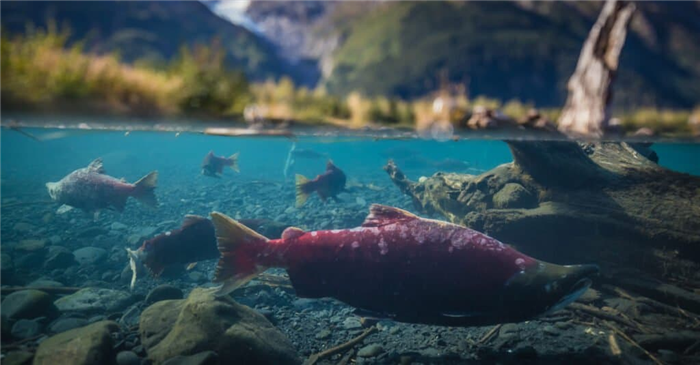
While in freshwater, salmon mostly eat insects like mayflies and fly larva
Salmon are one of the most commonly farmed and caught fish in the world. The process of farming and harvesting salmon is called aquaculture, and it has increased more than tenfold in the last four decades, surpassing naturally caught fish by a margin of 2.3 million tons.
Salmon farms are made up of hatcheries and sea cages, the latter being pens made of mesh that measure over 100 feet across and 30 feet deep. These farms are set up in natural water systems to provide salmon with an easily managed living situation. Still, the captive salmon are fed by the farm operators in addition to eating naturally occurring foods like zooplankton.
In salmon farming operations, the most common food served to the growing fish is dry pellets colloquially called “salmon pellets.” They contain a variety of ingredients based on which company supplied them, but common ingredients include:
- Plant and vegetable material
- Grains
- Fishmeal
- Vitamins
- Minerals
- Amino acids
These pellets are fed to salmon at regular intervals to bolster their growth and get them ready to be harvested. Once they have reached the right size, they are usually transported in wet-well ships directly to the processing plant, cutting down on processing time and ensuring the meat remains fresh.
How Much Do Salmon Eat?
Salmon are believed to need about 50 grams of food each day if they are 60 centimeters long or more. That is not a great deal of food, especially when considering that salmon regularly weigh more than 10 pounds.
Farmed salmon need less food because they spend less energy seeking out their next meal. Unlike salmon swimming in the ocean that need to find and eat another creature, their meals are regularly scheduled. The amount of feed pellets that salmon eat in captivity varies, but they usually grow about a pound for every 1.2 pounds of feed they consume.
Salmon that return to their spawning grounds stop eating once they hit freshwater. That means they need a significant amount of stored energy before their journey back to where they were spawned, a time called the salmon run.
During the salmon run, the fish makes its way back to where it started life, rarely eating, if at all. Once the fish successfully reproduce, the vast majority of them begin to deteriorate and die. They put all their energy into that final act, ensuring the future for the next generation. A few survive, and some even make the journey back out to sea.
What Predators Hunt Salmon?
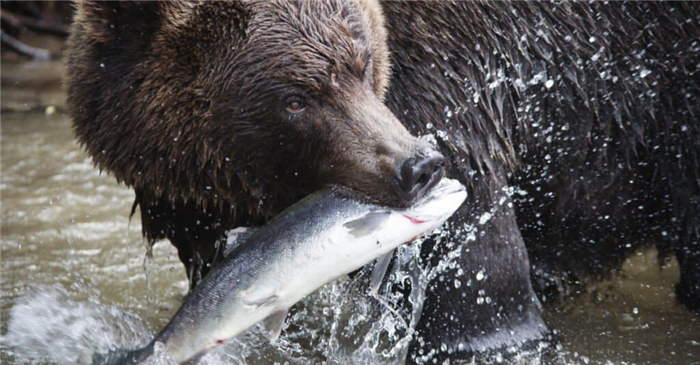
Salmon are often consumed by bears and other predators in freshwater
Salmon, not having much in the way of protective measures, often fall prey to other creatures. Their agile swimming and infrared sight can steer them out of harm’s way in some cases, but not always. Chiefly among their predators are humans, who catch salmon in freshwater and saltwater or farm them for food. In this way, millions of salmon are harvested and killed every year.
Humans are not the only cause of death for salmon. Consider this list of salmon predators:
These are all common salmon predators, capturing them in freshwater, saltwater, often at inopportune times such as when they’re leaping out of the water to travel or clean their scales.
Salmon are rather unique fish. They’re one of the most successfully farmed fish in the world, and their ability to return to their original spawning grounds is wondrous to behold.
Since they live in such different areas throughout their lives, salmon encounter a lot of foods. Salmon eat a variety of creatures throughout their lives, including insects, other fish, shrimp, and even the odd mollusk. Yet, a great deal of salmon subsist on the salmon pellets and remain in fish farms for their entire lives.
Share this post on:
Kyle Glatz
I’m a freelance writer with 8 years of experience. I’ve written in a variety of niches such as video games, animals, and managed service providers. I graduated from Rowan University in 2014 with degrees in English and Education. When I’m not working, I enjoy playing video games, reading, and writing for fun.
What Do Salmon Eat?
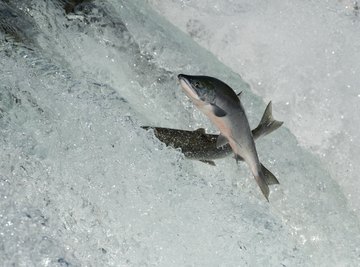
Salmon are a tasty, tempting and readily available fish that can add a healthy staple to any diet. In fact, entire regimes, like Dr. Hoffman’s “Salmon and Salad Diet,” have been built around this meaty and magnificent fish. While all this salmon feasting is going on, folks may forget that salmon have their own tasty food selection on which they dine.
Features
Salmon eat meat, or at least meat and protein products, as the little critters are definitely carnivores. In the wild, salmon may dine on zooplankton and small invertebrates. Once they get a tad bigger, salmon can readily eat smaller fish, like herring, or the shrimp-like critter called krill. Salmon kept in farms are usually fed a ground-up mixture of other fish and organisms from the ocean.
Salmon comes in nearly as many types as there are ways to prepare them for dinner. Atlantic salmon swim about the Atlantic Ocean, while the Pacific Ocean features seven different salmon varieties. They include:
- cherry salmon
- Chinook salmon
- chum salmon
- Coho salmon
- pink salmon
- Sockeye salmon
Still more salmon is found in primarily fresh water, these are the steelhead or rainbow trout and the cutthroat.
Geography
Salomon hatch in fresh water, migrate to the ocean and then return to fresh water to create new young. Most are generally found in streams and tributaries leading to either the Atlantic or Pacific oceans. Atlantic salmon is much more common on restaurant menus, even in places abutting the Pacific like California, because they are the type that are usually farmed. A couple of varieties are only found in Asian seas and still more salmon are found primarily in fresh water basins. Popular salmons places in the United States include Alaska, the Great Lakes and the Pacific Northwest, namely Washington, Oregon and Northern California.
While salmon are busy eating plankton and the like, plenty of things are ready to feast on salmon. This hearty, thick fish is a great staple for humans, who love salmon steaks broiled, seared or rubbed in spicy Cajun seasonings and thrown on a grill. Other creates that delight on dining salmon include birds, bears, sea lions, dolphins and larger predatory fish.
What Do Salmon Eat? Complete Feeding Guide And Facts
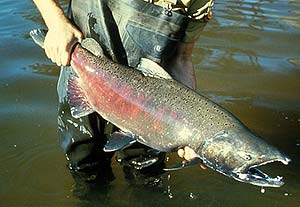
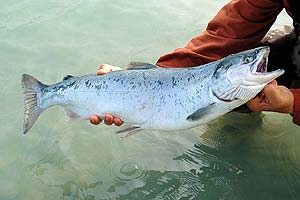
Show all photos 1
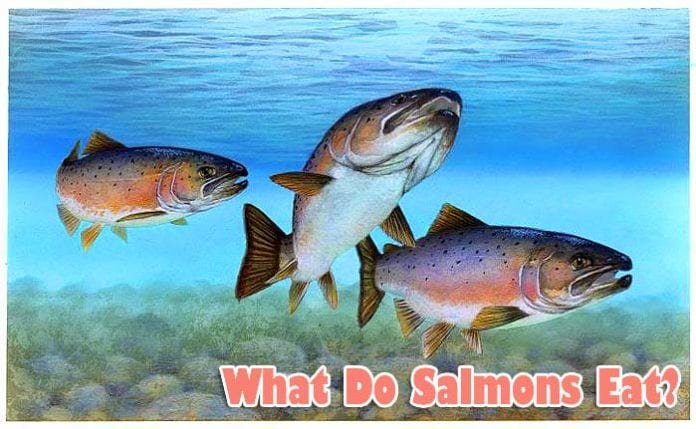
Published on Oct 27, 2021
10 mins to read
Get inspiration for education!
Subscribe for virtual tools, STEM-inspired play, creative tips and more
Salmon farming has a lot of potential in terms of meeting the rising demand for food due to the surge in the worldwide population.
Salmon is a popularly farmed fish in the wild and commercially cultivated, with farmed Atlantic salmon being the most widely available. It is becoming the world’s fastest-growing food production industry, compared to wild salmon collected.
Salmon is a good source of protein and nutrients like omega-3 fatty acids and various vitamins and minerals. A 3.5 oz (100 g) serving of farmed salmon includes 41% of the required daily protein consumption and at least 20% of the daily recommended intake of vitamins: B12, B6, B5, B3, D, E, and selenium. It is also high in potassium, making it an excellent meat substitute for consumption.
The name salmon is derived from the Latin ‘Salmo,’ which in turn emerged from the word ‘salire,’ which means to jump. Salmon are anadromous, they originate in fresh water, migrate to the ocean to grow, and come back to fresh water to spawn. Salmon species are generally classified into two genera: Salmo and Oncorhynchus. The Atlantic Ocean is home to the Atlantic salmon species of the Salmo genus. While, the Pacific Ocean has seven different salmon belonging to the Oncorhynchus genus: cherry salmon, Chinook salmon, chum salmon, coho salmon, pink salmon, and sockeye salmon. Some salmon species are landlocked, spending their whole lives in freshwater and only migrating to big lakes. Such salmon populations can be found across their range, such as steelhead, or rainbow trout, and cutthroat trout; these may be found predominantly in freshwater.
By scaling up aquaculture, we are expected to meet the growing demands in the future for the world’s protein needs and reduce pressure on wild fish stocks, allowing them to regenerate. Additionally, new markets and aquatic products are now available for trading on a global scale.
Salmon constitutes quite a significant portion of the diet, notably, in the United States and Europe. Chile, Norway, Scotland, Canada, and the Faroe Islands all rely primarily on salmon aquaculture. Atlantic salmon is also farmed in Russia, Tasmania, and Australia, however, in minimal quantities. Salmon fish farming began as a trial in 1960, but it became a corporate entity in Norway in the 1980s and Chile in the 1990s.
The salmon farming production cycle lasts around three years. Farmed salmon are raised in controlled water conditions during the first year, until being transferred to seawater habitats. When farmed salmon reach a harvestable size, they are transferred to processing factories, where they are prepared for sale.
Isn’t it exciting to discover what salmons eat? Before getting into insights, don’t forget to discover more related articles, such as what do frogs eat? And what do iguanas eat?
What do Atlantic salmon eat?
So, what exactly do they eat? Salmon devour a wide variety of foods in the wild, but their natural habitat determines their particular menu. In general, salmon are carnivores and enjoy a meat-based diet. When they’re young and born in rivers, they eat terrestrial and aquatic insects, amphipods, krill, and other crustaceans; as these fishes grow and migrate to sea as adult salmon, they begin to eat other fish. Since salmon have a diverse diet in the wild, it might be challenging for salmon farmers to ensure that every single meal meets the maximum potential of growth and sustainability in their feed. Hence, salmon growers are looking for solutions that balance nutrition and environmental challenges to achieve global dietary recommendations.
The Atlantic salmon is the biggest member of the Salmo genus and can thrive in freshwater as well as saltwater. These Atlantic salmon are generally 28-30 in (0.71-0.76 m) long and weigh 8-12 lbs (3.62-5.44 kg), although, they have been caught weighing more than 10 lbs (45.35 kg). Commercial fishing related to Atlantic salmon is prohibited in the United States; consequently, only farm-raised Atlantic salmon may be obtained in US seafood stores.
In their wild habitat, young Atlantic salmon begin to eat within a few days of hatching. They begin to hunt once the yolk sac has been absorbed into the body, known as alevin. In freshwater, juveniles prey on small invertebrates like crustaceans, including krill, euphausiids, amphipods, decapods, and aquatic insect larvae like mayflies, black flies, caddisflies, and stoneflies. However, as these Atlantic salmon develop, they start their first migration from their native stream to the ocean. This migration forms quite an image and is difficult to miss. Here, the Atlantic salmon diet includes a diverse range of species, including herring, capelin, mackerel, sand lance, barracudina, lanternfish, and smelts. A survey of the content related to Atlantic salmon stomachs reveals that while fish may constitute the majority of the diet in terms of weight, shrimps may constitute 95% of the meal in terms of quantity.
As they return to freshwater to spawn, adults cease feeding completely just before migration to rivers to begin the spawning journey.
What do Chinook salmon eat?
This salmon gets its name from the Chinookan people. It is also known as king salmon because it is the most significant species of Pacific salmon. It also includes several distinct names such as Quinnat salmon, Tsumen, spring salmon, chrome hog, Blackmouth salmon, and Tyee salmon.
This species prefers cold water with temperatures no higher than 710F (250C). While in the wild habitat, young Chinook salmon diet includes insects, amphipods, and other crustaceans; as they grow into adults, they primarily consume other fishes such as herring. Young salmon eat in rivers and streams only for a short period before migrating into the ocean and procuring more food. They may grow as long as 4.9 ft (1.49 m) and as heavy as 129 lbs (58.5 kg), although the average adult length and weight are around 3 ft (0.9 m) and 30 lbs (13.6 kg).
Did you know that to attract a spawning partner, salmon can change color? At the same time, the majority of Pacific salmon perish soon after spawning. The majority of salmon species have a life span of 2-7 years, but an average of 4-5 years of life. Steelhead trout have a life span of around 11 years. Pacific salmon use all of their energy returning to their home stream, laying eggs, and excavating the nest. When they return to freshwater, most of them stop eating and are unable to return to the ocean after spawning due to a lack of energy. When they die, they either become food for other animals or decompose, releasing nutrients into the streams. However, unlike Pacific salmon, Atlantic salmon do not die after spawning but survive and reproduce again.
What do salmon eat in the Great Lakes?
Few salmon species like Chinook, coho, pink, sockeye, and two Atlantic salmon species have been introduced into non-native habitats like the Great Lakes of North America. It is said that the word anadromous does not apply to salmon in the Great Lakes, as they enter the water, get landlocked, and spend most of their lives in the Great Lakes. Specifically, coho and pink salmon never migrated to the sea. Chinooks were first introduced in the 1870s, but they ended up failing. In 1966, Michigan, New York, Wisconsin, and Ontario joined together to reintroduce them.
The salmon diet in the Great Lakes includes crustaceans, smelt, alewives, forage, and other tiny fish found in freshwater. They stop feeding when their spawning period begins. Unlike Chinook in the Pacific Ocean, landlocked Chinook prefers water depths of less than 100 ft (30.48 m). Chinooks in the Great Lakes mature at a slower rate than Chinooks in the ocean, due to differences in feed supplies. Salmon are assumed to have stopped eating in rivers, however, in recent research these fish prey on their eggs and the eggs of other salmon, furthermore, even eggs of other marine animals while spawning in rivers.
What do farmed salmon eat?
Aquaculture provides a source of income and livelihood for millions of people around the world.
Salmon farming of species like Atlantic salmon or Pacific salmon starts with broodstock being picked from seaside production stocks and placed into water tanks about two months before stripping. Before laying eggs in trays or silos, they are scraped dry, fertilized with milt, water hardened, and disinfected. Some eggs may be shocked as they get changed from one container into another and are then inspected and unfertilized eggs are removed. Hatching occurs in hatchery trays or after transfer to tanks. Immediately after hatching, the larvae, now known as an alevin, resemble the form of the egg; they are around 70% yolk and 30% embryo. Alevins are generally kept in gloomy settings and given a matting or rocky substrate to simulate the natural gravel base. Fry are tiny fish that have just emerged from their gravel nest, commonly known as a redd. The two most significant elements influencing egg and alevin development and survival during the incubation phase, are oxygen and temperature.
From here, eggs and alevins are typically incubated in water at 50°F (10°C). Following yolk sac absorption, alevins will swim up in the water column, indicating that now they are ready to eat for the first time. First, feeding with inert foods is usually done after transferring fresh alevins into tanks; however, the feed is provided in hatchery trays at first.
Fry catch food in the water, mainly insect nymphs and larvae, and plankton. Feeding to fry can be cultivated in tanks utilizing flow-through, or different recirculation systems, or lake cage systems later on. Salmon fry can take up to 1-3 years in their home stream or lake to grow, depending on the species. At this stage, fish is maintained at ambient temperatures and natural light levels to develop as smolts. When these smolts weigh around 1.4- 4.23 oz (40-120g) they are transported to sea sites and modified for saltwater survival. To adapt salmon to the alterations in their body caused by saline water, they are fed with a plentiful supply of insects and crustaceans, such as herring and small shrimps. As adults, they are fed with a blend of fish oil, fish meal, and vegetable ingredients. Only around 30 fries from a redd of 2000-2500 eggs survive to become smolts, and only around four survive to become adults.
It is significant to have a nutrient-rich feed for salmon because it plays a significant part in farming profitability and provides the salmon with all the protein and vital elements that provide the nutrient-dense meals that support healthy growth.
Farmed salmon diet is dry pellets made of 70% vegetable constituents and 30% marine raw matters such as fishmeal and fish oil.
Getting into the specifics, the fish feed contains vegetable components originating from plants such as soy, corn, rapeseed, sunflowers, broad beans, and wheat, which serve as proteins, carbohydrates, and fat sources. Other marine ingredients, such as fishmeal and fish oil are made from byproducts of the seafood processing industry that are not suitable for human consumption. This supplies salmon with necessary additional proteins and minerals. It also aids in providing them with a high dimension of the omega-3 fatty acids EPA and DHA.
In addition, the fish feed contains a balanced quantity of vitamins, minerals, pigments, and amino acids. This is what makes fishmeal so appealing as a protein supplement for being a feed component.
It also includes the antioxidant, astaxanthin, which helps to improve the salmons’ immune system and protect their tissue, as well as providing a source of vitamin A. The red color in food is attributable to astaxanthin, which they obtain from eating crustaceans in the wild.
It is important to have high-quality fishmeal that improves overall disease resistance by strengthening and maintaining a healthy, functioning immune system.
Here at Kidadl, we have carefully created lots of interesting family-friendly facts for everyone to enjoy! If you liked our suggestions for what do salmon eat? Then why not take a look at what do koi fish eat or salmon facts?
Written By
The Kidadl Team is made up of people from different walks of life, from different families and backgrounds, each with unique experiences and nuggets of wisdom to share with you. From lino cutting to surfing to children’s mental health, their hobbies and interests range far and wide. They are passionate about turning your everyday moments into memories and bringing you inspiring ideas to have fun with your family.
Read The Disclaimer
Disclaimer
At Kidadl we pride ourselves on offering families original ideas to make the most of time spent together at home or out and about, wherever you are in the world. We strive to recommend the very best things that are suggested by our community and are things we would do ourselves – our aim is to be the trusted friend to parents.
We try our very best, but cannot guarantee perfection. We will always aim to give you accurate information at the date of publication – however, information does change, so it’s important you do your own research, double-check and make the decision that is right for your family.
Kidadl provides inspiration to entertain and educate your children. We recognise that not all activities and ideas are appropriate and suitable for all children and families or in all circumstances. Our recommended activities are based on age but these are a guide. We recommend that these ideas are used as inspiration, that ideas are undertaken with appropriate adult supervision, and that each adult uses their own discretion and knowledge of their children to consider the safety and suitability.
Kidadl cannot accept liability for the execution of these ideas, and parental supervision is advised at all times, as safety is paramount. Anyone using the information provided by Kidadl does so at their own risk and we can not accept liability if things go wrong.
Sponsorship & Advertising Policy
Kidadl is independent and to make our service free to you the reader we are supported by advertising.
We hope you love our recommendations for products and services! What we suggest is selected independently by the Kidadl team. If you purchase using the buy now button we may earn a small commission. This does not influence our choices. Please note: prices are correct and items are available at the time the article was published.
Kidadl has a number of affiliate partners that we work with including Amazon. Please note that Kidadl is a participant in the Amazon Services LLC Associates Program, an affiliate advertising program designed to provide a means for sites to earn advertising fees by advertising and linking to amazon.
We also link to other websites, but are not responsible for their content.
Where do Salmons fit in the Animal Food Chain?
Salmon play a significant role in the animal food chain.
- In their role as prey, these organisms offer a good source of nutrient to a large number of organisms including the endangered orcas.
- They also predate on many organisms which include but not limited to eels, squids, small fish, zooplankton and aquatic insects.
- Because of this, salmon regulate the local population of these small organisms by preventing overpopulation.
In general, the existence of salmon in the animal food chain ensures the existence of a high-quality ecosystem.
On the downside, as their habitats are depleted and destroyed by activities like damming, salmon disappear, which implies a reduction in the quality of their ecosystem.
